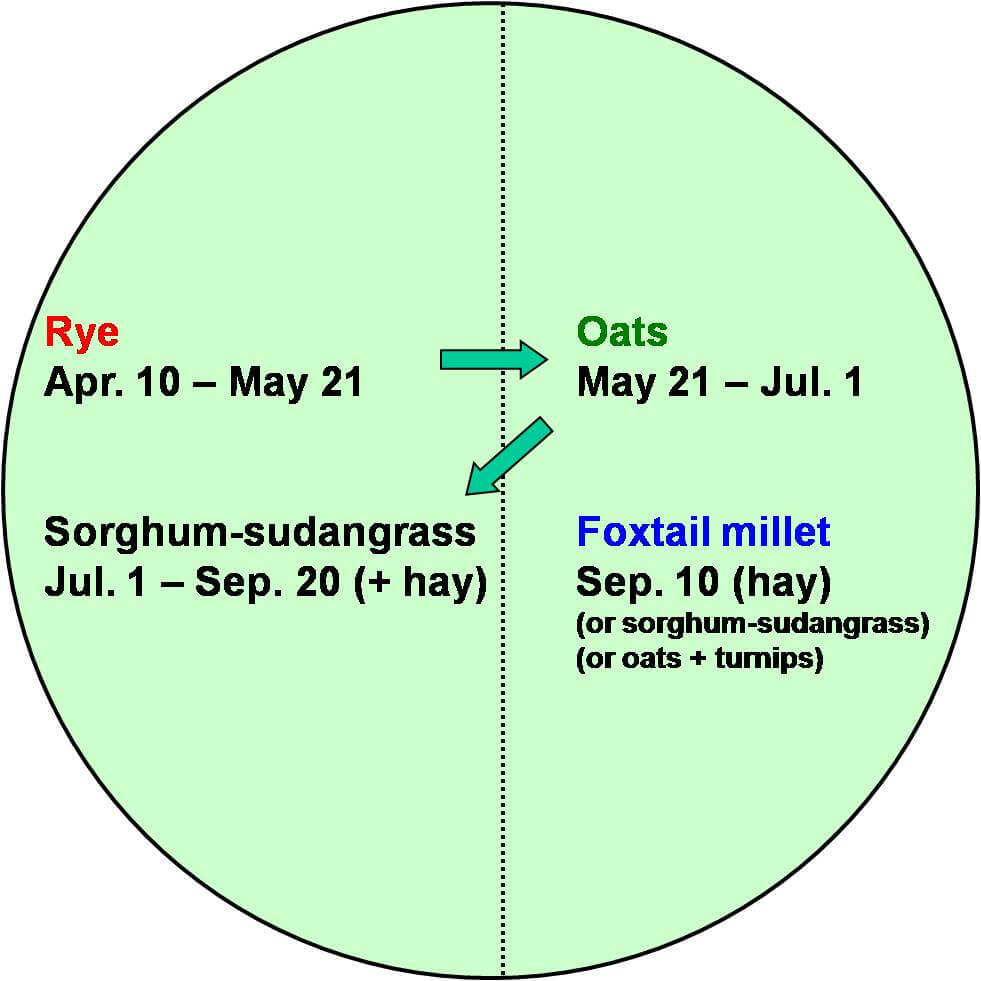Pasture Improvement
Your grazing strategy is the best tool you have to improve the hydrologic condition of your pastures, improve plant vigor, improve species diversity, and improve wildlife habitat.
To further improve pasture resources, you may need to remove undesirable shrubs or trees, overseed pastures, or plant new pasture land. Your local NRCS, Conservation District, or Extension can help you plan for pasture improvement. Cost-share funds may be available.
Certified Perennial Grass Varieties Recommended for Nebraska
Switchgrass, Big Bluestem, and Indiangrass for Grazing and Hay
That’s another reason we’re putting more of those grass mixes under a pivot, for drought, so you have that to graze in an emergency or wean on. I guess you’ve just got the feeling of confidence where you can make it through the summer of a drought without having to sell some of your herd. A kind of insurance.
Irrigated Pasture - Forage Choices
Having some irrigated pasture can be a viable option for some livestock producers that can lessen the impacts of drought on their forage resources.
Most irrigated pastures are seeded almost exclusively to perennial cool-season species, complementing the warm-season native range in a grazing system. Where water for irrigation is limited, warm seasons are more water use efficient and may be useful for irrigated summer pasture. Mixing cool- and warm-season grasses in the same irrigated pasture to obtain sustained season-long production is not advisable, as they are difficult to establish and maintain.
For a detailed discussion, see Perennial Forages for Irrigated Pasture, by J. Volesky et. al.
Annual Forages
 Double cropping annuals for forage. Image: Jerry Volesky
Double cropping annuals for forage. Image: Jerry Volesky
You may also want to consider working planted forage resources into your feed strategy. During drought, it is not advisable to rely on dryland farm ground for feed resources. However, crops that fit into a specific planting window are worth exploring, particularly if they can take advantage of sporadic or seasonal moisture and lessen grazing pressure on stressed rangelands.
Cool season annuals
Cool-season annuals with potential as forage crops include winter annuals, such as wheat, rye, and triticale and spring planted annuals such as oats or barley. Adequate soil moisture during germination and early seedling growth is also important for cool-season annuals planted for forage. While moderate water stress during vegetative stages can reduce yield, it often leads to improved forage quality.
Oats can also be planted in late July or early August with potential to produce 2.0 to 2.5 tons forage per acre for fall use. However, water needs during August and early September can be relatively high, reducing its production efficiency, especially when compared to spring-planted oats. Annual species including turnips, rapeseed, and other brassicas, either planted alone or in mixtures have also been used for forage. Adequate water for these small-seeded species is important during germination and early growth because of their shallow planting depth. Cover crops for forage, sometimes referred to as forage cocktails are diverse mixtures of several cool- and/or warm-season grasses, legumes, and broadleaf plants that are either spring or summer planted.
 Season-long grazing with annuals. Image: Jerry Volesky
Season-long grazing with annuals. Image: Jerry Volesky
Warm season annuals
Although warm-season annual grasses such as foxtail and pearl millet, sudangrass, sorghum-sudangrass hyrbrids, and teff have a relatively high heat unit requirement, they are among the most water use efficient plants used for forage. In addition to having adequate soil moisture during germination and early seedling growth, adequate precipitation or irrigation during the rapid growth periods of these species will result in the greatest response in forage yield. Most warm-season annuals are planted in late May to early June when soil temperatures reach appropriate levels. However, trials have shown that planting them after wheat harvest (mid to late July) may result in forage production of about 2.5 tons/acre for foxtail millet and teff and about 4 tons/acre for sorghum-sudangrass hybrids.